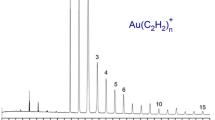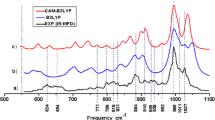Abstract
The gas-phase chemistry of AgFe+ was studied by using Fourier transform ion cyclotron resonance mass spectrometry. AgFe+ is unreactive with alkanes but reacts with cyclic and linear (C4–C8) alkenes. The primary reactions are dominated by dehydrogenation and condensation. In addition, cluster splitting is observed in the reaction of AgFe+ with benzene. Secondary reactions generally involve cluster splitting with the loss of Ag, although AgFeC5H +6 is observed to dehydrogenate cyclopentene to yield AgFeC10H +12 . Ion-molecule reactions, collision-induced dissociation, and photodissociation experiments were used to determine the bond energiesD°(Fe+−Ag)=53±7 kcal/mol andD°(Ag+−Fe)=46±7 kcal/mol. These values in turn were used to calculateΔH f (AgFe+)=296±7 kcal/mol andIP(AgFe)=6.5±0.3 eV. Related chemical and physical properties of CuFe+ are presented for comparison.
Similar content being viewed by others
References
R. Whyman,in B. F. G. Johnson (ed.),Transition Metal Clusters (Wiley & Sons, New York, 1980).
R. E. Smalley,in R. J. Bartlett (ed.),Comparison of Ab-Initio Quantum Chemistry to Experiment (D. Reidel Publ. Co., Dordrecht, Holland, 1985), pp. 53–65.
P. A. Montano, G. K. Shenoy, E. E. Alp, W. Schulze, and J. Urban (1986).Phys. Rev. Lett. 56, 2076.
G. A. Ozin and D. F. McIntosh (1986).J. Phys. Chem. 90, 5756.
S. W. Buckner and B. S. Freiser,in D. H. Russell (ed.),Gas Phase Inorganic Chemistry (Plenum Press, New York, 1989), pp. 279–321.
E. C. Tews and B. S. Freiser (1987).J. Am. Chem. Soc. 109, 4433.
D. B. Jacobson and B. S. Freiser (1985).J. Am. Chem. Soc. 107, 1581.
D. B. Jacobson and B. S. Freiser (1986).J. Am. Chem. Soc. 108, 27.
R. L. Hettich and B. S. Freiser (1985).J. Am. Chem. Soc. 107, 6222.
Y. Huang, S. W. Buckner, and B. S. Freiser,in P. Jena, B. K. Rao, and S. N. Khanna (eds.),Physics and Chemistry of Small Clusters (Plenum, New York, 1987), pp. 891–895;
Y. Huang and B. S. Freiser (1988).J. Am. Chem. Soc. 110, 387.
S. W. Buckner and B. S. Freiser (1989).J. Phys. Chem. 93, 3667.
L. M. Roth, B. S. Freiser, C. W. Bauschlicher, Jr., H. Partridge, and S. R. Langhoff (1991).J. Am. Chem. Soc. 113, 3274.
R. B. Cody and B. S. Freiser (1982).Int. J. Mass Spectrom. Ion Phys. 41, 199;
R. B. Cody, R. C. Burnier, and B. S. Freiser (1982).Anal. Chem. 54, 96.
R. C. Burnier, G. D. Byrd, and B. S. Freiser (1981).J. Am. Chem. Soc. 103, 4360.
M. B. Comisarow, V. Grassi, and G. Parisod (1978).Chem. Phys. Lett. 57, 413.
M. B. Comisarow and A. G. Marshall (1976).J. Chem. Phys. 64, 110.
W. K. Meckstroth and D. P. Ridge (1984).Int. J. Spectrom. Ion Phys. 61, 149;
D. J. A. Fredeen and D. H. Russell (1987).J. Am. Chem. Soc. 109, 3903.
J. H. Ng and B. S. Freiser (unpublished results).
D. B. Jacobson and B. S. Freiser (1983).J. Am. Chem. Soc. 105, 7484.
S. G. Lias, J. E. Bartmess, J. F. Liebman, J. L. Holmes, R. D. Levin, and W. G. Mallard,Journal of Physical and Chemical Reference Data (American Institute of Physics and the American Chemical Society, New York, 1988), Vol. 17, Suppl. 1.
R. L. Hettich and B. S. Freiser,in M. C. Buchanan (ed.),Fourier Transform Mass Spectrometry: Evolution, Innovation, and Applications (American Chemical Society, Washington, D. C., 1987), pp. 155–174.
S. W. Buckner and B. S. Freiser (1988).Polyhedron 7, 1583.
A. R. Miedema, inFaraday Symposia, Diatomic Metals and Metallic Clusters (The Faraday Division, The Royal Society of Chemistry, London, 1980), pp. 136–148.
J. L. Franklin, J. G. Dillard, H. M. Rosenstock, J. T. Herron, K. Draxl, and F. H. Field,Ionization Potentials, Appearance Potentials, and Heats of Formation of Gaseous Positive Ions (Nat. Stand. Ref. Data Ser., Nat. Bur. Stand., Washington, D.C., 1969), p. 261.
Author information
Authors and Affiliations
Rights and permissions
About this article
Cite this article
Ng, J.H., Gord, J.R. & Freiser, B.S. Heteronuclear diatomic transition-metal cluster ions in the gas phase: Reactivity and thermochemistry of AgFe+ . J Clust Sci 2, 43–56 (1991). https://doi.org/10.1007/BF00702934
Received:
Issue Date:
DOI: https://doi.org/10.1007/BF00702934




